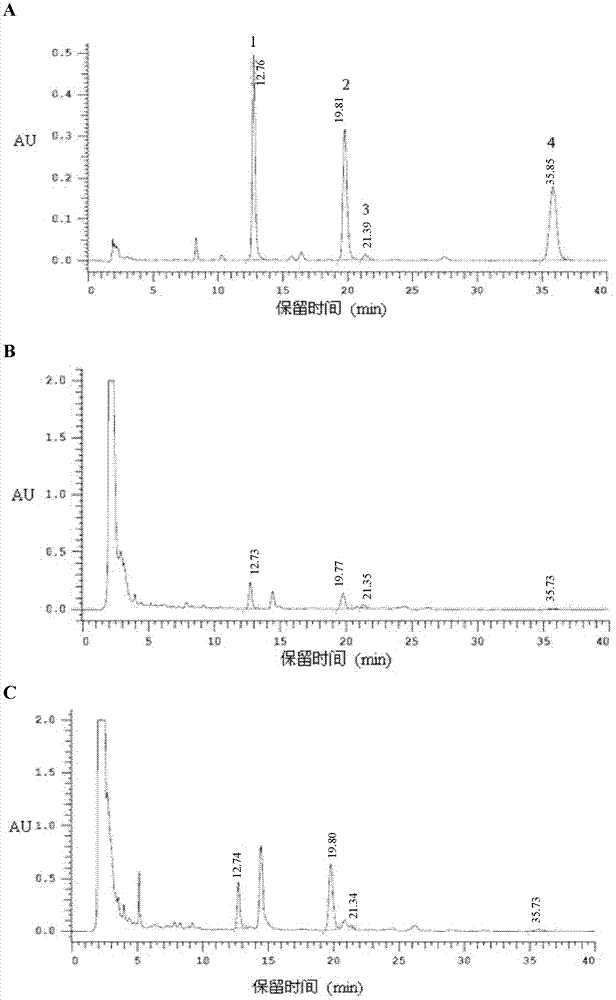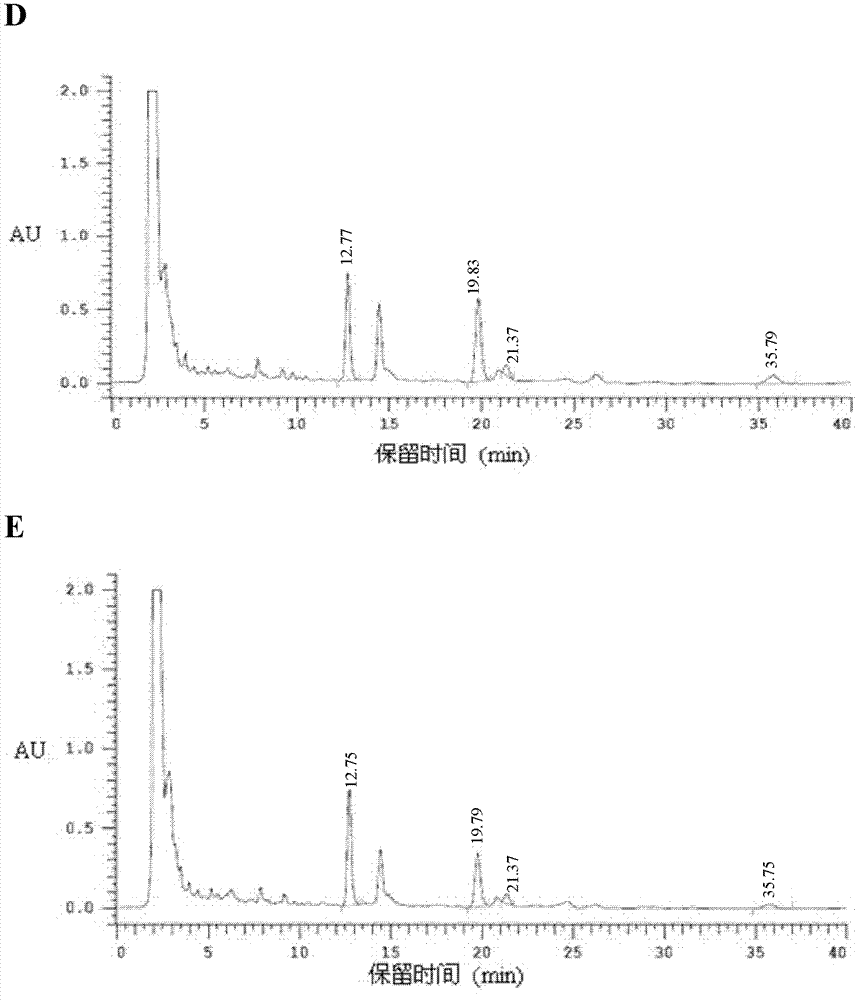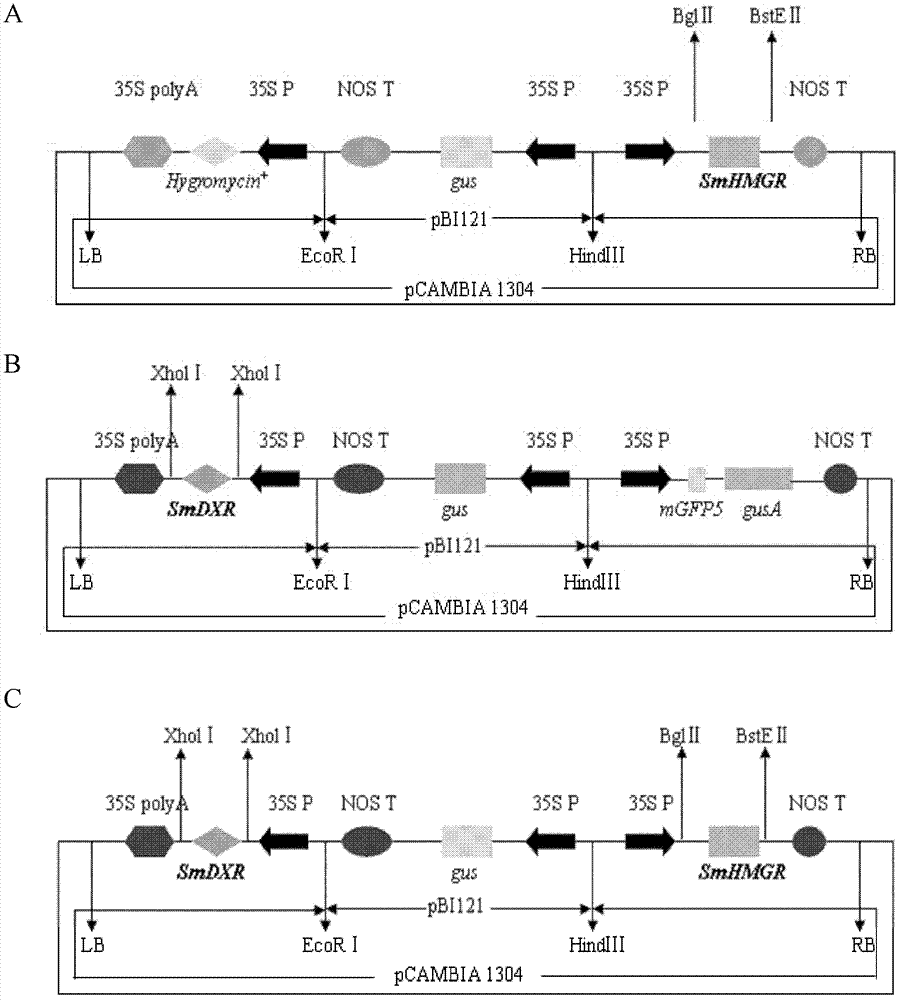Method of increasing content of tanshinone in hairy roots of salvia miltiorrhiza bunge through cotransformation of SmHMGR and SmDXR double genes
A technology of tanshinone content and hairy roots, applied in the fields of botanical equipment and methods, biochemical equipment and methods, genetic engineering, etc.
- Summary
- Abstract
- Description
- Claims
- Application Information
AI Technical Summary
Problems solved by technology
Method used
Image
Examples
Embodiment 1
[0031] 1.1. Salvia miltiorrhiza total RNA extraction and cDNA first-strand synthesis
[0032] Total RNA was extracted from the transgenic hairy roots of Salvia miltiorrhiza using the RNA prep pure plant kit provided by TIANGEN (see the instructions in the kit for the extraction steps). The fresh weight of Salvia miltiorrhiza transgenic hairy root used for extracting total RNA is about 0.1 g, and the DNA in the sample has been removed with DNase I working solution during the extraction process. Measure the relative absorbance value of the extracted RNA on a spectrophotometer, and calculate the purity and concentration of the extracted RNA. After calculation based on the concentration of different RNA samples, the first-strand cDNA was synthesized with reverse transcriptase XL (AMV) using 0.5 μg RNA as the initial amount (for the operation steps, refer to the relevant instructions provided by TaKaRa Company).
[0033] 1.2. Design of SmHMGR and SmDXR coding sequence-specific pri...
Embodiment 2
[0035] Example 2 Construction of plant expression vectors containing Salvia miltiorrhiza SmHMGR and SmDXR genes
[0036] 2.1. Intermediate vector pCAMBIA1304 + build
[0037] Using pBI121 and pCAMBIA1304 as materials, construct the plant expression vector pCAMBIA1304 + . Specifically, pBI121 and pCAMBIA1304 were digested with HindIII / EcoRI; the pBI121-GUS expression cassette and the large fragment of pCAMBIA1304 were recovered; ligation transformation was carried out, and single clone colonies were picked to extract plasmids for digestion verification. The results showed that the plant expression vector pCAMBIA1304 + The construction was successful, including CaMV35S promoter and terminator, multiple cloning site, replication origin and kanamycin resistance site.
[0038] 2.2. Plant expression vector pCAMBIA1304 + - Construction of SmHMGR (see figure 1 )
[0039] The successful pCAMBIA1304 constructed above + Basically, replace the GUS gene with the SmHMGR gene cloned ...
Embodiment 3
[0045] Example 3 Agrobacterium rhizogenes Mediates SmHMGR and SmDXR Gene Genetic Transformation of Salvia Miltiorrhiza to Obtain Transgenic Hairy Roots
[0046] 3.1. Containing plant expression vector pCAMBIA1304 + -Acquisition of SmHMGR / SmDXR Agrobacterium rhizogenes engineering bacteria
[0047] The plant expression vector pCAMBIA1304 containing SmHMGR and / or SmDXR gene in embodiment 2 + -SmHMGR / SmDXR was transferred into Agrobacterium rhizogenes pBiA4, and a single clone colony was picked for PCR verification. The results showed that the plant expression vector containing SmHMGR and SmDXR genes had been successfully constructed in Agrobacterium rhizogenes strain pBiA4.
[0048] 3.2. Genetic transformation of Salvia miltiorrhiza mediated by SmHMGR and SmDXR genes by Agrobacterium rhizogenes
[0049] 3.2.1. Preculture of explants
[0050] Cut the healthy aseptic seedling leaves of Salvia miltiorrhiza (0.5cm 2 ), inoculated onto the pre-culture medium (1 / 2MS), and culture...
PUM
 Login to View More
Login to View More Abstract
Description
Claims
Application Information
 Login to View More
Login to View More - R&D
- Intellectual Property
- Life Sciences
- Materials
- Tech Scout
- Unparalleled Data Quality
- Higher Quality Content
- 60% Fewer Hallucinations
Browse by: Latest US Patents, China's latest patents, Technical Efficacy Thesaurus, Application Domain, Technology Topic, Popular Technical Reports.
© 2025 PatSnap. All rights reserved.Legal|Privacy policy|Modern Slavery Act Transparency Statement|Sitemap|About US| Contact US: help@patsnap.com



